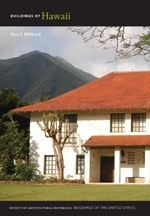
With its commanding, square bell tower and Gothic-arched openings, Kalahikiola stands in distinct contrast to most of the missionary Congregational churches built in Hawaii during the 1840s and 1850s. Such detailing as the sunburst patterns within the pointed arches, shutters, and the entrance's six-panel sliding doors further distinguish the building. This basilican-plan, stone church replaced a four-year-old thatched structure which blew down in a storm in 1849. The building's construction consumed six years and was a major undertaking for the Hawaiian congregation. Stones were gathered from the neighboring countryside, and timber had to be drawn overland by teams of men for some eight to twelve miles, an endeavor which was undertaken twice a week. The wood came from the forests of Kalahikiola, from which the church took its name. The addition of the bell tower and the shingling of the east end were undertaken in 1858 in order to eliminate moisture that was seeping through the masonry walls. An earthquake in October 2006 severely damaged the stone walls.

